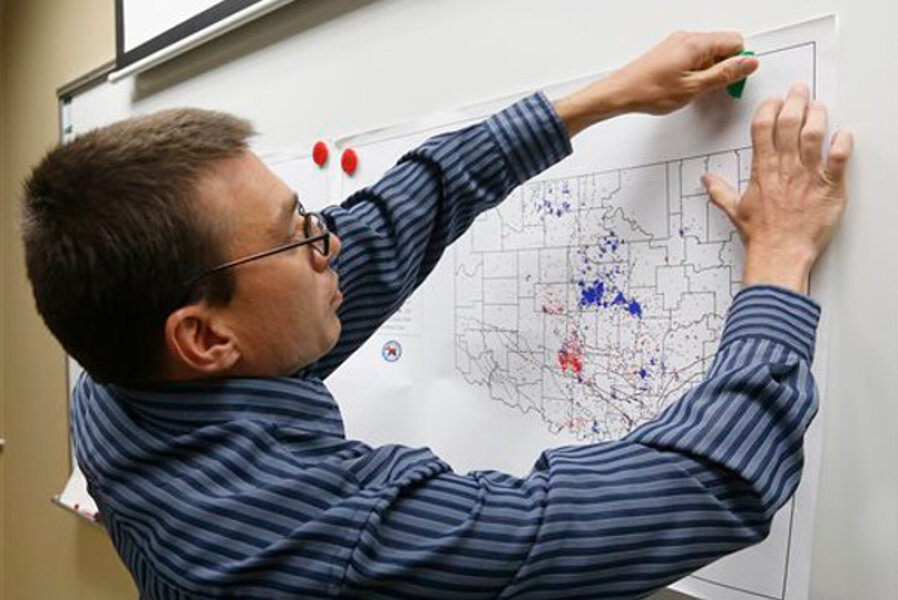Fracking FAQ: What's the link between injection wells and earthquakes?
Loading...
| FORT WORTH, Texas
States where hydraulic fracturing ("fracking") takes place have seen a surge in earthquake activity, raising suspicions that the unconventional drilling method could be responsible. Blame is focusing on the wells where the industry disposes of its wastewater.
Fracking generates vast amounts of wastewater, far more than traditional drilling methods. The water is pumped into injection wells, which send the waste thousands of feet underground. No one knows for certain exactly what happens to the liquids after that. Some scientists wonder whether they could trigger quakes by increasing underground pressures and lubricating faults.
Oklahoma has recorded nearly 250 small-to-medium earthquakes since January, according to statistics kept by the U.S. Geological Survey. That's close to half of all the magnitude 3 or higher earthquakes recorded this year in the continental United States.
A study published earlier this month in the journal Science suggests that just four wells injecting massive amounts of drilling wastewater into the ground are probably shaking up much of the state, accounting for one out of every five quakes from the eastern border of Colorado to the Atlantic coast.
Another concern is whether injection well operators could be pumping either too much water into the ground or pumping it at exceedingly high pressures.
Most of the quakes in areas where injection wells are clustered are too weak to cause serious damage or endanger lives. Yet they've led some states, including Ohio, Oklahoma and California, to introduce new rules compelling drillers to measure the volumes and pressures of their injection wells as well as to monitor seismicity during fracking operations.
Here are some answers to key questions about the phenomenon:
___
Q: HOW MANY QUAKES HAVE THERE BEEN NEAR WASTEWATER INJECTION AREAS?
A: Researchers are still debating the appropriate parameters for measuring the link between injection wells and earthquakes, including at what distances injections can possibly stimulate quakes. Previously seismologists had linked injection wells to earthquakes occurring within 3 miles of injection sites, but a new study tracks earthquakes as far as 20 miles away from wells.
___
Q: HOW DAMAGING HAVE THEY BEEN?
A: No injuries or deaths have been reported, but there has been varying degrees of property damage. Most of the quakes are big enough to be felt but too small to do damage like classic California or Japanese quakes. In the North Texas city of Azle, which has endured hundreds of small earthquakes since fracking and injection well activity began, residents have reported sinkholes, cracks in the walls of homes and air and water quality concerns. Two structures collapsed during Oklahoma's 5.7-magnitude earthquake in 2011.
___
Q: WHAT DOES THE MOST RECENT RESEARCH SAY ABOUT THE LINK BETWEEN THE TWO?
A: Studies on the swarms of temblors in central Oklahoma, Ohio and North Texas have found probable links between injection wells and earthquakes, with the caveat that a dearth of information on conditions underground before the injections began makes it difficult to unequivocally link them to quakes. However, studies more than 50 years old have linked injection wells to tremors in Colorado.
___
Q: HOW DOES THE OIL AND GAS INDUSTRY RESPOND TO THESE STUDIES?
Wastewater injection disposal does risk inducing earthquakes, said Dana Bohan with Energy In Depth, a research and education arm of the Independent Petroleum Association of America, a Washington-based group that represents thousands of oil and natural gas producers. However, Bohan said, very few events have been documented over the decades in which the disposal wells have been in operation.
___
Q: ARE SMALL QUAKES PRECURSORS TO LARGER QUAKES?
A: Large earthquakes follow small earthquakes about 1 percent of the time, according to Stephen Horton, research scientist at Center for Earthquake Research and Information at the University of Memphis. However, when earthquakes are induced by wastewater injection, large quakes typically do follow smaller ones, depending on the quantity of water injected into the subsurface, Horton said.
Danielle Sumy, a postdoctoral researcher at the University of Southern California and a former USGS visiting scientist, was the lead researcher on a study published in March that said a magnitude-5.0 quake in Oklahoma induced by nearby wastewater injection early on Nov. 6, 2011, set off subtle pressure changes that triggered earthquakes along the fault, almost like dominoes, before finding relief in the 5.7 temblor later that day.
___
Juozapavicius reported from Tulsa, Okla. AP Science Writer Seth Borenstein contributed from Washington.
Copyright 2014 The Associated Press. All rights reserved. This material may not be published, broadcast, rewritten or redistributed.





